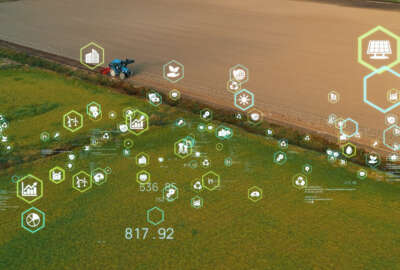Lesson learned: A long ago federal agriculture project that did not work out
An old book about a failed New Deal era agriculture project has been re-issued by the conservative American Enterprise Institute.
It is an eternal question. How much should government try to do? Now we present a view you may not hear all that often. An old book about a failed New Deal era agriculture project has been re-issued by the conservative American Enterprise Institute. First published in 1951, the book, “Government Project,” detailed the Agriculture Department’s attempt at establishing a cooperative farm from the ground up in Arizona. The author, Edward Banfield, was a Harvard urban studies professor and one-time federal information officer. He died in 1999. For more, the Federal Drive Host Tom Temin spoke with Kevin Kosar, who wrote the forward to the reprint and is a Senior Fellow with the American Enterprise Institute.
Interview Transcript:
Tom Temin In Edward Banfield’s book, which you have prefaced called Government Project, detailed something that no one alive remembers barely back in 1937, in what is now a pretty populous county, Pinal County, Arizona, crisscrossed with highways. But back then it wasn’t so populated. And what was the Government Project, and what happened to it that caused you to write about this.
Kevin Kosar Government Project is the story of a really well-intended but ill fated government intervention during the Great Depression in the Dust Bowl. The idea was that you had large numbers of small farmers who had lost their farms, and you also had large numbers of migrant farmers. These were a group of poor people who move from place to place. The Okies that John Steinbeck described in his great book Of Mice and Men. And they were desperately poor. They were malnutrition. And the federal government got this idea, that Roosevelt administration, that well, they want a farm, let’s create a farm for them. So they got thousands of acres of land. They irrigated it. They built roads, they built brand new houses with the latest amenities. And then they recruited these folks to come farm. But here was the kind of big detail. They weren’t getting individual farms, because the individual farm was not viable economically. They were going to have to farm cooperatively. And this was a project that went on for about seven years before ultimately just imploding.
Tom Temin And why did it implode? Simply because there was no profit motivation on the part of the people recruited to go farm there.
Kevin Kosar Well, there were a couple of problems with it. Part of it was the way the project was structured was inherently contradictory. On the one hand, it aimed at producing full employment for everybody who lived there. On the other hand, it needed to be sufficiently efficient to cover its operating costs and hopefully bring in a profit. And so incidents arose where they found that they just didn’t need as many people who lived there, because they found a more efficient way to milk the cows or to do something else. But if they switched, what are those people going to do? And so that created problems. There was also a tension between telling the people that they were part of a cooperative, versus you’re just here to work on a corporate farm. The belief was that this farm ultimately should be run by these individuals. Yet at the same time, it was government owned. Taxpayers had paid for it. It was government asset. So you had the officials from the Farm Security Administration frequently overruling the people who were supposed to have the authority to make judgments about how they ran the farm. They butted heads a lot. And so, ultimately, when the federal government decided it was going to get out of the business and they offered the farm to the people who live there for a very good deal. The people said, no, we’re sick of doing this. We want to have our own individual farms. And so it just collapsed.
Tom Temin Yeah. And to some degree, it’s the old issue or the now old issue of people in Washington feeling they understand a mechanism out there in the market better than the people out there in the market. Is that one of the lessons learned?
Kevin Kosar Yeah, certainly. One of the lessons learned was the government was trying to fight both technology and the economy. The reason these people had lost their farms was in part, we were seeing mega farms develop. We had the great invention. Instead of having the cows and or the oxen being used to plow the fields, you suddenly had these machines. But these machines were expensive, so it tends to be corporations that could afford the machines, and they would buy up lots of land while they’re trying to basically create a counterbalance to that sort of economic development, which is perilous stuff. It also indicates that policymakers, if they’re going to try to help people, they really need to understand the people’s worldview a lot better. Ultimately, these folks were hardcore individualists. They were used to either running their own farms or moving from place to place and just doing what they wanted. And to suddenly throw them in a situation where they’re in a highly structured environment and they’re expected to cooperate for the greater good, it was a lot to ask of people.
Tom Temin We’re speaking with Kevin Kosar. He’s senior fellow at the American Enterprise Institute. And in 2024, what do you think is the lesson we can draw from this story, this anecdote? It’s a big anecdote.
Kevin Kosar Yeah. There are a lot of lessons. One is that it wasn’t more than a century ago that most Americans, their communities, were created by virtue of where they settled, who they went to, religious services with. That was kind of who they were. Their world was defined in that sort of way. Fast forward now, we’re all cosmopolitans. And more and more of our lives are being structured by rules and efforts at rationality. And this is new for human beings and how we’re coping with it, well, we’re struggling. And whether we will ultimately be able to cope with it, that is a big open question. The other kind of up to date lesson is a reminder that making public policy is really hard in a republic. It’s one thing if you have a fascist who can simply command something and everybody has to get in line or they’ll be shot. It’s another thing when you have a pluralist, representative democracy and you have a lot of voices in the room who are trying to put together a plan to deal with something, and then ultimately, they have to coordinate it. A lot of moving parts got to be put in place for something to work out right. And this book is a story of just how those pieces just couldn’t come together.
Tom Temin Yes. Because government in many ways in this country has a dilemma, because we’ve gotten to the point where there’s almost no problem that someone doesn’t feel there is a federal solution for. And back then, the disappearance of the farms, the farm crisis, the drought, the dustbowl seemed like such a big problem. And it was. It was a very real problem at the human scale and at the large economic scale, because there was a depression going on that only the government has the resources to be able to get around this. In some sense, that was true. In some sense, it really wasn’t true of depending on your point of view of history and what really happened. So how does that translate to some of the issues that people think require a large federal response today? What can we learn now? Say people think the climate is changing, or they think that we need to change the basis of the entire way we give ourselves energy, those kinds of things.
Kevin Kosar Yeah. Well, I’m hoping that the book will first help us resist the initial twitch that I think we all tend to feel much more than our forebears did. That, as you say, I see a problem. Why isn’t government doing something about it? Why is it Washington doing something about it? That’s a habit of mind we’ve gotten into, and I think we should get over that and think twice, if not three times, before calling on Washington. The second thing is that problems, we shouldn’t think of them as like mathematics, like they’re to be solved. In many cases, the best you can do if you’re lucky enough to be successful, is to ameliorate them a little bit. How much money, for example, have we tried to spend trying to end poverty, trying to fix poverty, trying to stop human privation and misery? Tens and tens of billions just keep going out the door and it’s still everywhere. And Government Project, that’s an example of the story. Go way back then. Federal government trying to help people and it didn’t work out. And that’s a hard thing, because nobody wants to see misery. Nobody wants to see that awfulness. But we have to be very careful about taking resources and throwing them at things and just hoping it’s going to work, because frequently it doesn’t.
Tom Temin Getting back to that location out there in Arizona, Pinal County. What’s there now, by the way?
Kevin Kosar You’re not going to find a big giant government farm, that’s for sure. No, it’s developing like just about everywhere else. There are still plots of land that are farm like. And that brings up an important point, which is human cooperation is essential for our flourishing. We’re all the better for it. The question is, how do we produce it and how do we do it in different realms? Certainly, free market economics can be really, really good at getting people to cooperate to do amazing things, whether it’s creating medical technology or the magic that allows us to sit here and be interviewed and broadcast out to untold listeners. Fantastic. Other things markets don’t work so well for and we turn to government. Other times, it’s probably more appropriate to turn to voluntary arrangements in order to make things happen. And figuring that all out is the great challenge of self-government.
Copyright © 2025 Federal News Network. All rights reserved. This website is not intended for users located within the European Economic Area.
Tom Temin is host of the Federal Drive and has been providing insight on federal technology and management issues for more than 30 years.
Follow @tteminWFED






